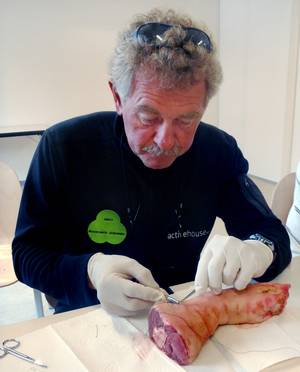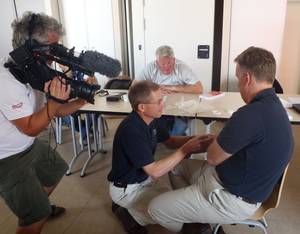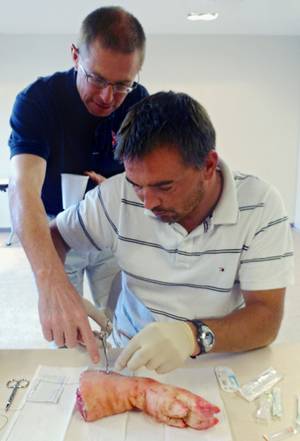
It is not every day you are asked to cut open a pig’s trotter with a sharp knife then stitch it back together again. But that’s exactly how the VELUX 5 OCEANS skippers spent an afternoon as they learnt how to cope with medical emergencies at sea. Ocean racers Brad Van Liew, Derek Hatfield, Zbigniew Gutkowski and Chris Stanmore-Major were put through their paces by Dr Spike Briggs and Dr Mark “Tommo” Tomson from Medical Offshore Support (MSOS) in a day of hands on medical training.
As well as navigators, engineers, sailmakers and cooks, the VELUX 5 OCEANS skippers must also become their own doctors – and in extreme cases, surgeons – trained to recognise and treat any illness or ailment they might pick up during their epic solo circumnavigation. Whether it is an illness such as a fever or an infection, or a physical injury such as a broken bone, the ocean racers have no choice but to deal with it themselves.
Fortunately, although the VELUX 5 OCEANS skippers may be alone in body, they are far from on their own should disaster strike. Thanks to modern communication technology MSOS experts will be on hand around the clock to make sure the skippers are given the best advice should something happen. MSOS have also designed medical kits for the skippers ensuring they will have all they need at sea.
Watch the medical training video – click HERE
As part of their comprehensive skipper support package, Spike and Tommo flew out to La Rochelle to run the sailors through dealing with all manner of medical emergencies from the treatment of common ailments such as dehydration and ‘gunwale bum’ (the result of sitting on wet decks all day long) to serious injuries like bone fractures and open wounds. The sailors got to practice stapling and sewing wounds back together on pig’s trotters as well as muscular injections. Spike and Tommo also showed them how to insert intravenous lines should they require a drip.

“We concentrate on physical skills during the training course such as suturing, inserting intravenous lines, immobilising fractured limbs, giving intra-muscular injections because although we can give all advice over the telephone, we can’t actually do the things for them,” said Spike.
“Running through the medical kit is also vitally important, so that when they open the kit in an emergency, it is not the first time they have seen inside it. Part of medical training for a single-handed race like the VELUX 5 OCEANS comprises of knowing how to treat oneself because there’s no-one else to do it for you, but also how to treat others in an emergency, in case a casualty is recovered from another boat or the sea.”
“As a solo ocean sailor you never want to be in one of these situations where you have to deal with medical emergencies or even perform surgery on yourself,” said Canadian ocean racer Derek Hatfield, skipper of Active House. “This medical course is invaluable. You don’t want the first time you have to perform a procedure such as suturing to be when you are alone at sea.”
The ability to cope with medical emergencies offshore has come on in leaps and bounds since the early days of solo ocean racing. Back then, sailors had no medical support whatsoever, save from their copy of the Ships Captain’s Medical Guide. In 1969, no-one was on the end of a phone to help British sailing legend Sir Robin Knox Johnston when he got battery acid in his left eye, or excruciating stomach pains that later turned out to be appendicitis.

Gutek is shown how to stitch wounds back together by Dr Spike Briggs
The past 28 years of the VELUX 5 OCEANS are littered with examples of sailors who have had to deal with all manner of medical problems. In the original VELUX 5 OCEANS race, held in 1982, medical support was limited. In the 1986 edition of the race French yachtsman Jean Luc Van Den Heede sailed to the aid of Finnish competitor Pentti Salmi, giving him antibiotics after Salmi got blood poisoning from diesel fuel getting into a cut.
During the 1998/9 race, Russian sailor Viktor Yazikov developed an excruciating infection in his elbow after injuring it on the first ocean sprint. In an amazing display of skill and composure, Yazikov performed open surgery on the infected wound, stopping the infection and ultimately saving his arm. He carried on racing and even beat some of the fellow competitors into port. Even before reaching the Bilbao startline in the last edition of the VELUX 5 OCEANS, New Zealand yachtsman Graham Dalton developed septicaemia during his qualification passage.
Other ocean races are full of similar stories. In the Vendée Globe in 1992, Bertrand de Broc was left with no option but to take needle and thread to his own tongue following an accident. Even with today’s high standards of medical support, accidents can and do happen. During the last edition of the Vendée Globe, Frenchman Yann Elies suffered every ocean racer’s worst nightmare: a broken bone. A huge Southern Ocean wave smashed into Elies’ yacht, fracturing his thigh bone. Two competitors, Britain’s Sam Davies and France’s Marc Guillemot, went to his aid but Elies was eventually rescued by an Australian Navy ship before being airlifted to hospital in Australia.